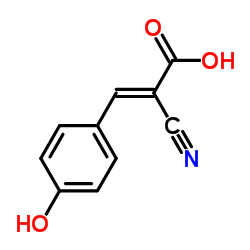α-Cyano-4-hydroxycinnamic acid

α-Cyano-4-hydroxycinnamic acid structure
|
Common Name | α-Cyano-4-hydroxycinnamic acid | ||
|---|---|---|---|---|
| CAS Number | 28166-41-8 | Molecular Weight | 189.167 | |
| Density | 1.4±0.1 g/cm3 | Boiling Point | 398.1±32.0 °C at 760 mmHg | |
| Molecular Formula | C10H7NO3 | Melting Point | 245-250 °C(lit.) | |
| MSDS | Chinese USA | Flash Point | 194.5±25.1 °C | |
| Symbol |

GHS07 |
Signal Word | Warning | |
|
Proteome mapping of epidermal growth factor induced hepatocellular carcinomas identifies novel cell metabolism targets and mitogen activated protein kinase signalling events.
BMC Genomics 16 , 124, (2015) Hepatocellular carcinoma (HCC) is on the rise and the sixth most common cancer worldwide. To combat HCC effectively research is directed towards its early detection and the development of targeted therapies. Given the fact that epidermal growth factor (EGF) i... |
|
|
Simple analytical strategy for MALDI-TOF-MS and nanoUPLC-MS/MS: quantitating curcumin in food condiments and dietary supplements and screening of acrylamide-induced ROS protein indicators reduced by curcumin.
Food Chem. 174 , 571-6, (2014) Curcumin is the major active ingredient of turmeric and is widely used as a preservative, flavouring and colouring agent. Curcumin is a potent substance with several functions, including antioxidant, antitumor, anti-inflammatory, antimicrobial, antiparasitic,... |
|
|
High-throughput workflow for identification of phosphorylated peptides by LC-MALDI-TOF/TOF-MS coupled to in situ enrichment on MALDI plates functionalized by ion landing.
J. Mass Spectrom. 50 , 802-11, (2015) We report an MS-based workflow for identification of phosphorylated peptides from trypsinized protein mixtures and cell lysates that is suitable for high-throughput sample analysis. The workflow is based on an in situ enrichment on matrix-assisted laser desor... |
|
|
Stable isotopic labeling-based quantitative targeted glycomics (i-QTaG).
Biotechnol. Prog. 31 , 840-8, (2015) Mass spectrometry (MS) analysis combined with stable isotopic labeling is a promising method for the relative quantification of aberrant glycosylation in diseases and disorders. We developed a stable isotopic labeling-based quantitative targeted glycomics (i-... |
|
|
N-(1-naphthyl) ethylenediamine dinitrate: a new matrix for negative ion MALDI-TOF MS analysis of small molecules.
J. Am. Soc. Mass Spectrom. 23(9) , 1454-60, (2012) An organic salt, N-(1-naphthyl) ethylenediamine dinitrate (NEDN), with rationally designed properties of a strong UV absorbing chromophore, hydrogen binding and nitrate anion donors, has been employed as a matrix to analyze small molecules (m/z < 1000) such a... |
|
|
Quantitative reproducibility of mass spectra in matrix-assisted laser desorption ionization and unraveling of the mechanism for gas-phase peptide ion formation.
J. Mass Spectrom. 48(3) , 299-305, (2013) In a previous study on matrix-assisted laser desorption ionization (MALDI) of peptides using α-cyano-4-hydroxycinnamic acid (CHCA) as a matrix, we found that the patterns of single-shot spectra obtained under different experimental conditions became similar u... |
|
|
Alkylated dihydroxybenzoic acid as a MALDI matrix additive for hydrophobic peptide analysis.
Anal. Chem. 84(9) , 4237-43, (2012) Hydrophobic peptides are generally difficult to detect using matrix-assisted laser desorption/ionization mass spectrometry (MALDI-MS) because the majority of MALDI matrixes are hydrophilic and therefore have a low affinity for hydrophobic peptides. Here, we r... |
|
|
Comparative genomics and metabolic profiling of the genus Lysobacter.
BMC Genomics 16 , 991, (2015) Lysobacter species are Gram-negative bacteria widely distributed in soil, plant and freshwater habitats. Lysobacter owes its name to the lytic effects on other microorganisms. To better understand their ecology and interactions with other (micro)organisms, fi... |
|
|
Catalytic activation of pre-substrates via dynamic fragment assembly on protein templates.
Nat. Commun. 5 , 5170, (2014) Sensitive detection of small molecule fragments binding to defined sites of biomacromolecules is still a considerable challenge. Here we demonstrate that protein-binding fragments are able to induce enzymatic reactions on the protein surface via dynamic fragm... |
|
|
The proteomic 2D-DIGE approach reveals the protein voltage-dependent anion channel 2 as a potential therapeutic target in epithelial thyroid tumours.
Mol. Cell. Endocrinol. 404 , 37-45, (2015) We investigated the role of VDAC2 in human epithelial thyroid tumours using proteomic 2D-DIGE analysis and qRT-PCR. We found a significant up-regulation of VDAC2 in thyroid tumours and in thyroid tumour cell lines (TPC-1 and CAL-62). We did not detect overexp... |